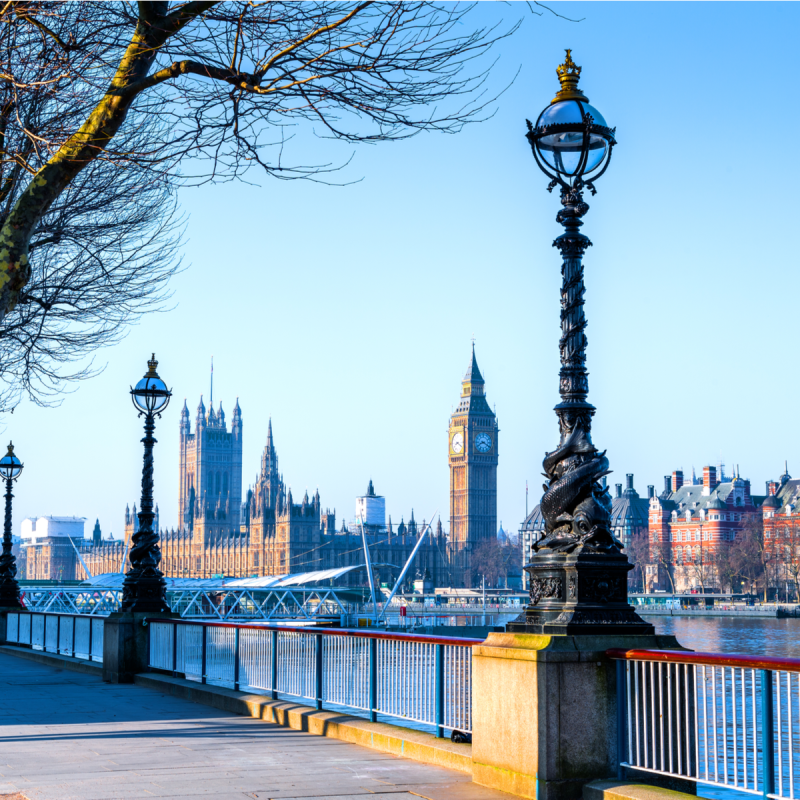
(Photo Credit: Paul Daniels / Shutterstock.com)
I will have to start this article with an apology, because in fact, there are two places I always visit when I am in London, not just the one. One is the Marylebone Neighborhood, but I have already written about this favorite neighborhood of mine. The other is South Bank, and I will tell you more about it here.
Videos by TravelAwaits
Both places are very different from each other, with Marylebone being more shopping-orientated, while South Bank is all about enjoying the proximity of the River Thames. And while there are so many sights to see along the Thames, I am always drawn to the southern side of the river, which invites you to walk, as well as stop off in so many places.
Bursting with everything from art to food, from walks to history, South Bank stretches officially between Lambeth Bridge and Lambeth Palace — the official seat of the Archbishop of Canterbury — past the London Eye to Blackfriars Bridge. That said, I tend to include the next two bridges, and for me, South Bank ends at either Millennium Bridge or a few steps on at Southwark Bridge. I hope that works for you.
This stretch of the city offers so much, and you are bound to end up adding it as one of your choice spots in London as well.
Here are my favorite things to do along London’s South Bank — somewhat extended in size for this writer’s purposes.

(Photo Credit: Sampajano_Anizza / Shutterstock.com)
1. The View Across To Westminster Palace
One of the reasons I love South Bank is the views. There is obviously the River Thames with its ships and boats, ferries, and water taxis. There are the bridges, ranging from old to newer, crossed by pedestrians, cars, iconic red double-decker buses, and trains. There is the typically grand London architecture, from the Palace of Westminster with Big Ben to Lambeth Palace, from the large white buildings along the Strand on the opposite side of the river, to St. Paul’s Cathedral. Then, slowly emerging as you walk, you’ll see the more modern additions to the London skyline, some of which already just as iconic as the older buildings, such as the Gherkin, the Cheesegrater, and the Shard.
All the views unfold as you walk, but there is also another way of catching them all in one go: from the London Eye. While not a great fan of these “eyes” that have been popping up in nearly every city, I do think everybody should go on them once, just to get a different perspective that you otherwise simply could not get.
Pro Tip: I am a great fan of enjoying a grand view with a glass of something special in my hand. Here you have options: You can book the Champagne Experience on the London Eye or pop up to the Queen Elizabeth Hall Roof Garden just behind the Eye, which, with its lovely garden and live music, is particularly lovely on a warm afternoon.

(Photo Credit: cktravels.com / Shutterstock.com)
2. The Southbank Centre And Hayward Gallery
When I was in London as an au pair, half a lifetime ago, the Southbank Centre (not a spelling mistake, the Southbank Centre is spelled as one word, but it stands on the South Bank), with its Brutalist architecture, was my second home. At the Southbank Centre, not only was there a shelf of free books, but also a cinema club that was free, or really cheap, I forget.
Today, the British Film Institute’s cinema is still on-site. And while the free books must have moved elsewhere, nearby is now the Hayward Gallery, which holds regular and superb exhibitions, such as the Louise Bourgeois, one that just finished. Sadly, this gallery is not free, and at £15 per person ($18.87), I have to admit that I often simply move on to the Tate Modern instead, unless there is an exhibition I am desperate to see.
Pro Tip: If you come on the weekend, you can take full advantage of the Southbank Centre Food Market, a selection of stalls offering you everything from Asian street food to hot dogs, from truffle-infused burgers to crêpes, and from coffee to wine and beer. Come with an empty stomach.

(Photo Credit: EQRoy / Shutterstock.com)
3. Leake Street Tunnel
Just by Waterloo Railway Station lies the Leake Street Tunnel, and the Leake Street Arches. For anybody interested in street art and skillful graffiti, this is a must-see. Compared to Brick Lane, probably the most famous area for urban art, this is just as good, if not better. The difference here is that the graffiti is legal and has been for years, and it is all done in a limited space. An outlet for street art without the threat of being punished for it has attracted many artists over the years, and the constantly changing displays are simply stunning. From Leake Street, the art spills over into the Leake Street Arches, eight former railway arches. The overall atmosphere is fabulous, with the young and old(er), professionals and families, tourists and locals walking through the area appreciating the ever-changing canvas it provides.
Pro Tip: Stop off at Banh Bao Brothers for lovely, fresh Vietnamese street food.

(Photo Credit: Elena Rostunova / Shutterstock.com)
4. Winter Market
This is a bit of a seasonal must-do, as the so-called Winter Market is in fact a traditional Christmas market that offers all the things you’d expect from continental Europe in winter: plenty of wooden chalets and twinkle lights, stalls selling gifts and Christmas decorations, and, of course, food and drink. As a German, when I cannot make it to Germany before Christmas and find myself in London instead, I tend to head straight to the German bratwurst stand. Give me sausages from the grill with a side of fries and mayonnaise, all washed down with a warm spiced wine, and I am in pre-Christmas heaven. The market spreads outside the Southbank Centre and tends to open in early to mid-November and stays open until just before Christmas.
Pro Tip: If you do find yourself in London before Christmas, also head to Hyde Park and the Winter Wonderland, which is a cross between a traditional Christmas market and a fun fair. It remains open over Christmas into the New Year.

(Photo Credit: JJFarq / Shutterstock.com)
5. OXO Tower
The iconic OXO Tower used to be a former power station, just like Tate Modern (see below), and provided power only for the Royal Mail. In the 1920s, the building was purchased by the company famous for making the OXO Beef Stock Cubes, which you will find in every English supermarket. The company wanted to advertise not only the repurposed building’s renovation in the stunning Art Deco style, but also its products, but was refused to do so by the city. So, the architects built three windows into the tower with two round designs, and two crossed between them, that, when illuminated, spelled OXO. (Very clever indeed.) Today, the tower is a destination in itself, with great shops, art galleries, and superb restaurants and cafes.
Pro Tip: Book yourself a space on the terrace of the OXO Tower Bar on the eighth floor, where you can sit outside and enjoy cocktails, with London spread out below you. It is particularly stunning at sunset when the city begins to sparkle.

(Photo Credit: Ron Ellis / Shutterstock.com)
6. Tate Modern
Tate Modern is hands down my favorite contemporary art space in London. I love the space itself, a former power station, which has been reimagined, taking something very industrial and making it into something that is perfect for displaying art — not unlike the Zeitz MOCAA in Cape Town. Then, there are the excellent exhibitions, but the fact that this is one of the many free museums in London is also very useful when you just want to pop in for a fix of art. And even though its 5.7 million visitors a year reportedly make it one of the most visited art galleries and museums in the world, the space is so enormous and well organized that it never feels cramped. When you are “done” with the art, you can either reflect while sitting on a swing downstairs, or shop in the superb bookstore and museum shop.
Pro Tip: For contrast, but still under the same umbrella, walk to the Tate Britain, just past Lambeth Palace on the other side of the Thames, for a more traditional setting and more traditional art.

(Photo Credit: Philip Ellard / Shutterstock.com)
7. Millennium Bridge
I love all the older bridges in London, I mean, what’s not to love about Tower Bridge, or Westminster Bridge? But Millennium Bridge, a hypermodern steel construction, and “only” a footbridge, is probably my favorite. Built by architect Norman Foster and appropriately opened in the year 2000, it is hugely photogenic, especially when you add a black and white filter. It is also hugely useful: connecting Southwark, or what I still call South Bank, with the Bank district and St. Paul’s Cathedral. In fact, you get a unique view of the cathedral from the middle of the bridge. Often referred to as the Wobbly Bridge, its initial wobble problems were quickly fixed and it is now steady, despite the often rather gusty London weather.
Pro Tip: You’ll recognize the bridge from films such as Harry Potter and the Half-Blood Prince and James Bond’s Spectre.
There is an abundance of activities to explore outside of South Bank in surrounding London:
